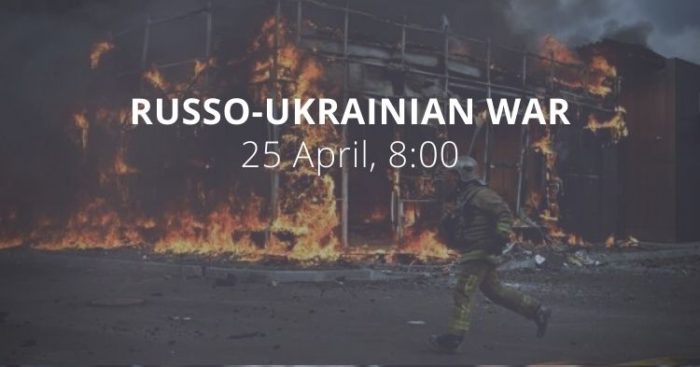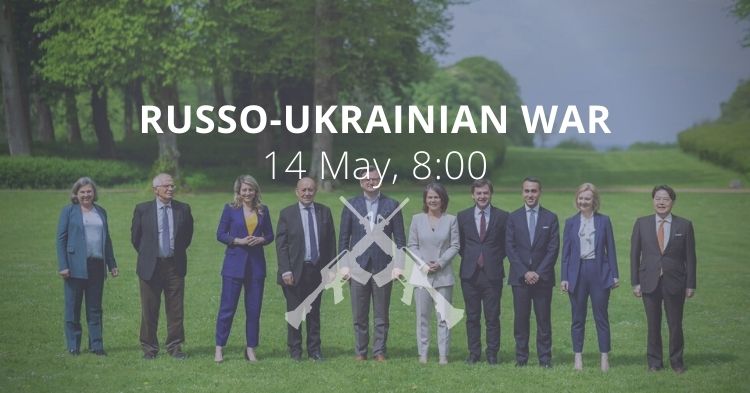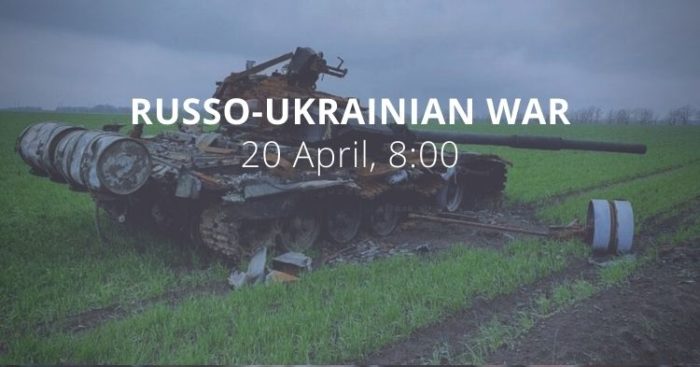Morning report day 68 – May 02
Putin's War - The Map Briefing for May 2nd.
Relatively few changes since the last update.
- Russia has advanced to the outskirts of Lyman and out from Lozove, pushing remaining Ukrainian forces North of the Donets River.
- Ukraine has advanced near Staryi Saltiv, unknown how far. pic.twitter.com/T78mTkKRpK— Nathan Ruser (@Nrg8000) May 2, 2022
Situation
According to information from the General Staff:
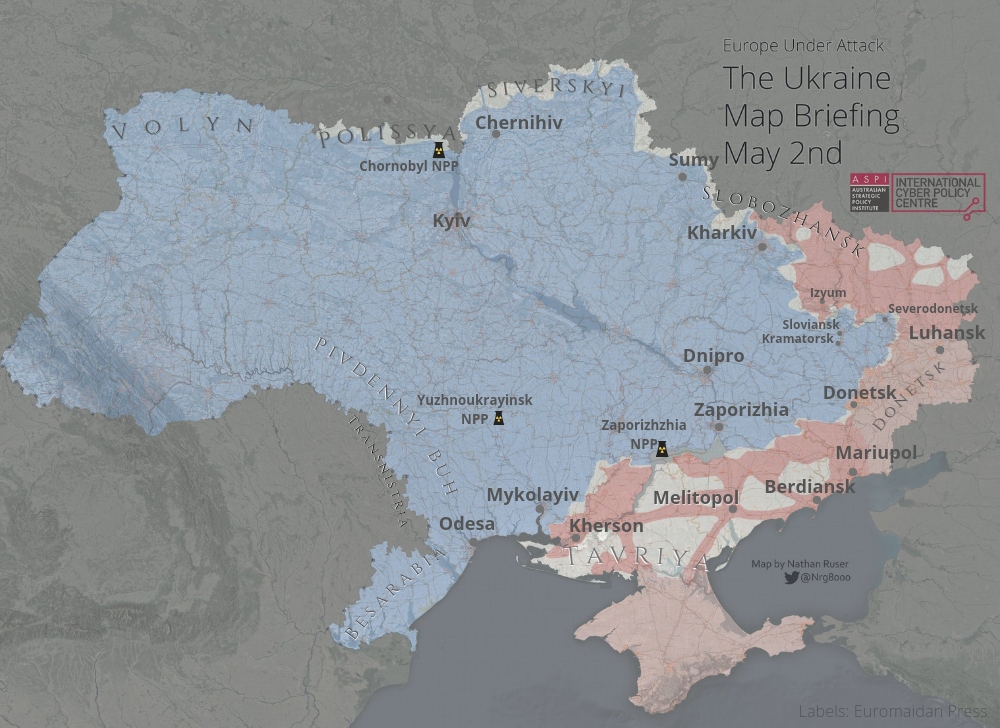
Units of the Armed Forces of the Republic of Belarus have been identified in the Volyn and Polissya areas and continue to carry out tasks to cover the Ukrainian-Belarusian border in the Brest and Gomel oblasts.
- Russian forces did not take active action. There is a threat of provocations in areas near the state border of Ukraine, accusing units of our defense forces.
- The threat of missile strikes on military and civilian infrastructure from the territory of the Republic of Belarus by the Russian forces remains.
In the Siversky direction, Russian forces fired mortars at the positions of Ukrainian troops in the Senkivka area of the Chernihiv Oblast.
- Intensified administrative-police and counter-intelligence regimes have been established in the Russian Bryansk Oblast bordering Ukraine. Checkpoints are located on the main roads and near the settlements.
- To clarify the position of our troops in the Sumy direction, Russian forces conducted air reconnaissance using UAVs.
- In the future, demonstration actions along the state border of Ukraine, as well as the resumption of fire damage to our units and infrastructure in the border areas in this direction are not excluded.
In the Slobozhansky direction, the Russian forces group continues to shell the city of Kharkiv and the settlements of Uda and Prudyanka.
- Russia forces’ offensive operations in the Izium-Barvinkove and Izium-Sloviansk directions continue in the Izium direction. The forces continued to fire on our troops.
- Russian occupiers also suffered casualties in the area of the village of Stary Saltiv.
- In the Izium direction, Russian forces tried to conduct offensive operations, were unsuccessful, and suffered losses in manpower and equipment.
In the Donetsk direction, Russian forces are conducting offensive operations along almost the entire line of contact.
- In the Lyman direction, Russian forces fired on the units of Ukrainian troops on the Lyman-Siversk border to oust them from their positions and create conditions for the attack on Sloviansk.
- In the Sievierodonetsk direction, Russian forces focused their main efforts on taking control of Rubizhne and preparing for the attack on Sievierodonetsk.
- In the Popasna direction, Russian forces tried to improve the tactical position in the Popasna area. Russian forces strengthened their troops by moving one battalion tactical group from the Mariupol direction.
- Russian forces tried to establish full control over the settlements of Rubizhne and Popasna, were unsuccessful, and suffered losses.
- Russian occupiers unsuccessfully stormed the settlements of Ozerne and Marinka. Russian forces also suffered losses in the area of the settlements of Vremivka and Zelene Pole.
- To increase the air defense system, Russian forces deployed additional anti-aircraft missile systems in the temporarily occupied and temporarily occupied territories of Luhansk and Zaporizhzhia oblasts.
In the Tavriya and Pivdenny Buh directions, Russian forces continue to try to improve their tactical position and shelling.
- In the Tavriya direction, measures are being taken to regroup Russian forces, increase the components of the fire destruction system, and engineer equipment for replenishment of ammunition and fuel and oil.
- In the Pivdenny Buh direction, the occupiers are trying to reach the administrative border of the Kherson Oblast, looking for weaknesses in Ukrainian defense. In the area of Mykolaiv, the Russian aggressor carried out air reconnaissance with the use of three UAVs. He fired artillery at the positions of our units.
- In the Pivdenny Buh direction, Russian forces are fighting with the forces of certain units in order to create favorable conditions for the attack on Mykolayiv and Kryvyi Rih.
- The main efforts of the occupiers focused on the Kryvyi Rih direction. They fired artillery at the positions of our units in the Tavriysky, Osokorivka, Trudolyubivka, and Knyazivka districts.
- In the Mykolayiv direction, Russian forces carry out a regrouping of divisions.
- In order to clarify the situation and identify the positions of our units, Russian forces conducted air reconnaissance with the involvement of UAVs in the eastern part of Mykolayiv and the north-western part of the Kherson oblasts.
During the previous day, air defense units hit ten Orlan-10 UAVs.
Russian forces suffer significant losses, especially in artillery and on land. In the Donetsk and Luhansk oblasts only, ten attacks by Russian occupiers were repulsed in the past 24 hours, two tanks, seventeen artillery systems, thirty-eight units of armored combat vehicles and 10 units of forces vehicles were destroyed.”
https://twitter.com/EuromaidanPress/status/1521108241341550592?s=20&t=4cvDI-ksEvNYBX9VOrZD0w
Ukrainian forces destroy 35 enemy troops, and 7 military equipment units in southern Ukraine, the Ukrinform reports. The relevant statement was made by the South Operational Command on Facebook. Russian troops lost seven military equipment units, including armored and motor vehicles, and multiple rocket launcher systems. The Armed Forces of Ukraine are maintaining the captured frontiers and preventing the enemy from advancing in the Mykolaiv direction. In addition to two unmanned aerial vehicles (UAVs) downed by Ukrainian defenders in the morning, the enemy lost one more Orlan-10 UAV when doing air reconnaissance.
Ukraine Says Russia Army Top General Wounded in Command Post Strike, ‘Dozens’ Killed, the Kyiv Post reports. Official Ukrainian sources on May 1 said devastating artillery strikes on a Russian military headquarters may have injured the senior general in the Russian Army, Valery Gerasimov, along with killing or wounding dozens of other military personnel, many of them senior members of the officer’s corps. A statement from Ukraine’s Army General Staff (AGS) said a pair of surprise bombardments hit Russian military command centers in the Izium area of the Kharkiv Oblast overnight April 30-May 1. The main target was an army HQ and the second was an HQ for an airborne infantry unit, the statement said.
Ukrainian media were quick to report the strikes wounded Gerasimov, but the claims were not repeated by official UAF sources. Oleksiy Arestovych, a presidential administration advisor frequently commenting publicly on military developments, in an April 30 evening interview said artillery “completely eliminated” a Russian command center near the Kharkiv regional village of Zabavne. He estimated the number of Russian officers and command center staff personnel killed and wounded in the strikes at between 100 and 300 personnel.
Putin's chief of staff Valery Gerasimov is 'wounded by shrapnel after being sent to Ukraine by the Russia president to secure victory', reports claim, the Daily Mail reports. Vladimir Putin's top military commander has supposedly been flown out of the war zone with shrapnel wounds after being sent to Ukraine by the Russian president to secure victory, a former Russian internal affairs minister has claimed. Valery Gerasimov, the chief of staff of the Russian army, was allegedly wounded in Izium in Ukraine's Kharkiv Oblast. Founder of independent Conflict Intelligence Team Ruslan Leviev said, however, that an eyewitness at the airport had later seen Gerasimov board the plane in Belgorod unaided. 'The source confirms that it was Gerasimov who flew away,' he posted.
https://twitter.com/EuromaidanPress/status/1521092157435781125?s=20&t=4cvDI-ksEvNYBX9VOrZD0w
In the Belgorod Oblast a Russian Federation Ministry of Defense facility is on fire, Ukrainska Pravda reports.
"On the border of three municipalities - Borisovsky and Belgorod districts and Yakovlev city district - there has been a fire on the territory of one of the facilities of the Ministry of Defense of the Russian Federation, the governor of the Belgorod Oblast Vyacheslav Gladkov wrote on Telegram
A bridge collapsed in the Kursk Oblast of Russia, the Ukrainska Pravda reports. The construction of a railway bridge has fallen in the Kursk Oblast of the aggressor country, the governor of the Oblast said. The railway line was allegedly used to move freight from storage. TASS later reported that the partial collapse of the railway bridge in the Kursk Oblast occurred because of sabotage. A case has been opened, Governor of the Oblast, Roman Starovoit, said on his Telegram channel.
Two explosions were heard in Russia’s Belgorod, the governor says, TASS reports. Two powerful blasts were heard in the Russian city of Belgorod in the early hours of Monday morning, Oblast Governor Vyacheslav Gladkov wrote on Telegram.
The governor of Belgorod region in Russia wrote about "two powerful explosions" which were heard at night.
He added that there were no injuries or damage, no casualties, and "footage of flashes in the sky has already appeared on social networks." https://t.co/x6SSwuX63s pic.twitter.com/9cIrUMcLB0
— Euromaidan Press (@EuromaidanPress) May 2, 2022
The Black Sea Fleet intensifies operations in the Black Sea - Operational Command "South", Ukrainska Pravda reports.
"An intensification of forces naval forces has been observed at Sea. After our last strike on Zmiinyi Zmiinyi (Snake) Island, the forces tried to evacuate and replenish the military personnel of their units on the island with the help of "Raptor" patrol speedboats," spokesman of the operational command "Pivden" Vladyslav Nazarov on Facebook. He added that the rest of the Russian warships and a submarine continue to uphold the threat of missile strikes on the territory of Ukraine at a high level.”
Russia's cyber-offensive operations in Ukraine have probably reached their maximum potential, the State Special Communications Service said, Ukrainska Pravda reports.
“Ukraine is still experiencing strong pressure in cyberspace from Russian hackers, but it is likely that their potential has already reached its maximum. They have already demonstrated all the available tools and technologies. The State Service says that, due to sanctions, Russian hackers will not be able to develop as they did before. However, the State Special Communications Service emphasises that Russian hackers are still a serious threat to the whole world. They should not be underestimated, but neither should they be overestimated.”
The State Service for Special Communications and Information Protection of Ukraine reports that the Russian occupiers have cut off communications and the Internet in Kherson and parts of Zaporizhzhia oblasts.
“Yesterday, residents of Kherson and parts of Zaporizhzhia oblasts first experienced interruptions to the Internet and mobile communications, and then these services disappeared in large areas. The problems that arose simultaneously with all mobile operators, as well as with fixed Internet service providers, are nothing more than another attempt by the occupier to leave Ukrainians without access to true information about the war waged by Russia against Ukraine; and make their false propaganda an unalterable source of information, as is being done in Russia itself.”
According to British Defense Intelligence
, (last 24 hours):
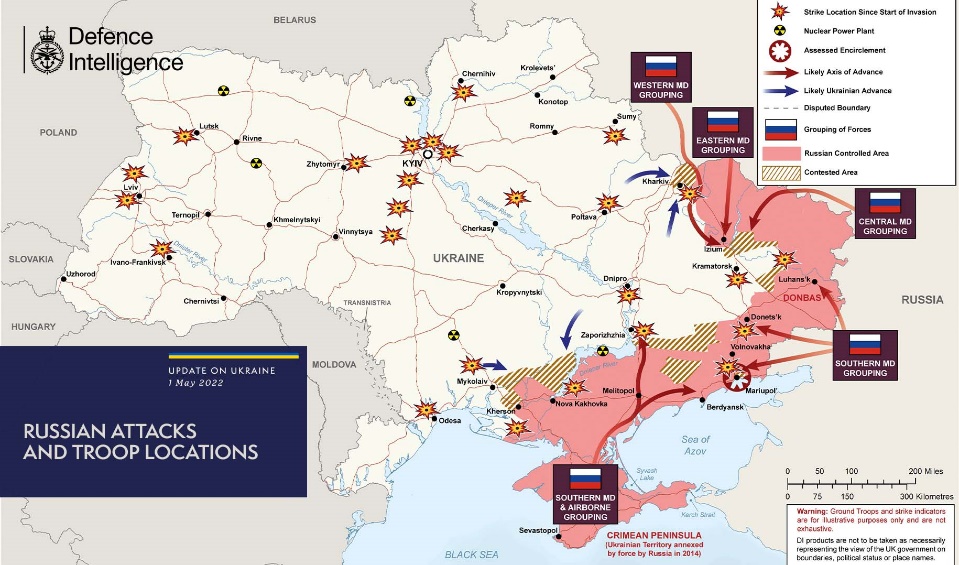
- At the start of the conflict, Russia committed over 120 battalion tactical groups, approximately 65 percent of its entire ground combat strength.
- It is likely that more than a quarter of these units have now been rendered combat ineffective.
- Some of Russia’s most elite units, including the VDV Airborne Forces, have suffered the highest levels of attrition. It will probably take years for Russia to reconstitute these forces.
As of Monday 02 May, the approximate losses of weapons and military equipment of the Russian Armed Forces from the beginning of the war to the present day:
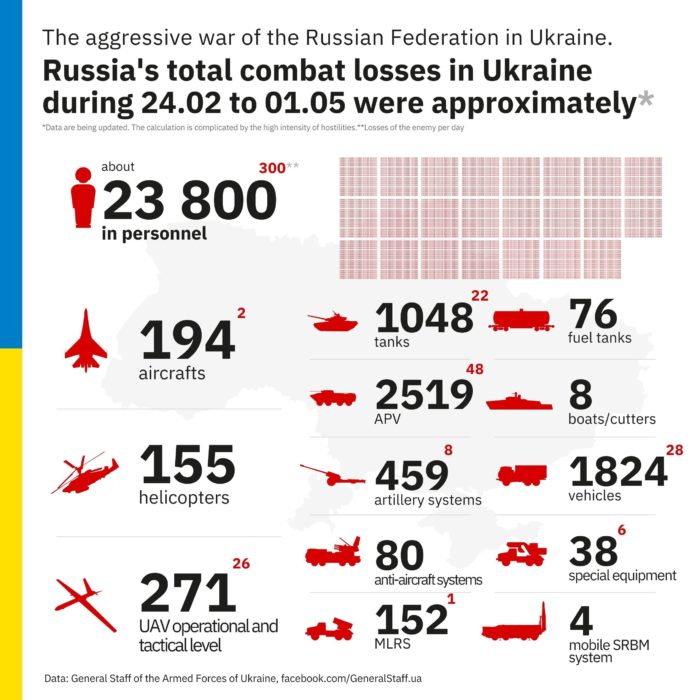
- Personnel – more than 23800 people (+300),
- Tanks – 1048 units (+22),
- Armored combat vehicles – 2519 units (+48),
- Artillery systems – 459 (+8),
- Multiple rocket launchers – 152 (+1)
- Air defense means – 80 (+3),
- Aircraft - 194 (+2),
- Helicopters - 155 (+0),
- Automotive technology and fuel tanks – 1824 (+28),
- Vessels/boats - 8 units (+0),
- UAV operational and tactical level – 271 (+26)
- Special equipment – 38 (+6)
- Mobile SRBM system – 4 (+0)
- Cruise missiles – 84
Humanitarian
Zelenskyy confirms the start of evacuation from Azovstal: the first hundred people are on their way to Zaporizhzhia, Ukrainska Pravda reports. "The evacuation of civilians from the Azovstal plant has begun. The first group of about 100 people is already heading to the controlled territory. Tomorrow, we will meet them in Zaporizhzhia, he wrote on Twitter. I’m thankful to our team! They, together with UN representatives, are currently working on the evacuation of other civilians from the plant."
According to UNHCR 5,468,629 refugees have been registered as of April 29 (Not updated due to 1 May). The UN says that so far Poland has taken in 3,014,157 refugees, Romania 817,303, Russian Federation 656,381, Hungary 519,979, Republic of Moldova 443,559, Slovakia 371,918 and Belarus 25,002. Among those who fled Ukraine are also Ukrainian nationals with dual citizenship. An additional 105,000 people moved to the Russian Federation from the Donetsk and Luhansk oblasts between 18 and 23 February.
The first wedding dance of Viktor and Oksana in the Lviv hospital ward. Oksana, a 23-year-old nurse from Lysychansk, lost her legs on 27 March. Then Oksana had turned to warn Viktor of the danger, and within a second a Russian mine exploded under her https://t.co/dKjMBdW4uv pic.twitter.com/QOgRboUgfv
— Euromaidan Press (@EuromaidanPress) May 2, 2022
The number of Ukrainians entering Ukraine since February 28 is 1,289,500 as of April 29. This figure reflects cross-border movements, which can be pendular, and does not necessarily indicate sustainable returns.
OHCHR recorded 6,134 civilian casualties in Ukraine as of April 28. 2,899 were killed (including 210 children) and 3,235 injured (including 309 children).
Actress Angelina Jolie visited Ukrainian children evacuated from Luhansk Oblast at Boryslav Rehabilitation Center in Lviv Oblast,–Boryslav City Council pic.twitter.com/EC56pZw490
— Euromaidan Press (@EuromaidanPress) May 2, 2022
Environmental
Over 4M tonnes of grain blocked in Ukrainian ports due to war – UN, the Ukrinform reports. Almost 4.5 million tonnes of grain have been blocked in Ukrainian ports.
“Exports through the closed sea routes are halted amid an ongoing Russian military invasion. This was stated by the UN World Food Program official Martin Frick, Ukrinform reports with reference to RFE/RL. Before the war, Ukraine was one of the world's largest wheat exporters and corn producers. Many countries rely on Ukrainian wheat supplies, according to the UN. Hunger should not become a weapon, Frick said. He called for the resumption of Ukrainian food supplies to other nations to alleviate the global food crisis.”
US Congressman McGovern calls for agricultural export corridors from Ukraine, the Ukrinform reports. It is necessary to help the Ukrainians establish a humanitarian corridor that will allow them to ship food by sea to other countries.
“The relevant statement was made by Chair of the House Rules Committee, Member of the US Congressional Delegation to Ukraine Jim McGovern at a briefing in Rzeszów, Poland. We also will continue to fund our international relief organizations like the UN World Food Programm and others. And we must find a way to help the Ukrainians establish a humanitarian corridor that will allow them to ship food by sea, to help the poorest people in the world, so they don’t go hungry, McGovern said.
In his words, Putin’s brutal war is no longer only a war against the people of Ukraine. It is also a war against the world’s most vulnerable. Ukraine is basically the breadbasket of the world that provides wheat, maize, sunflower oil and many other things to countries all around the world, especially in Africa and in the Middle East. It provides important food to relief organizations, such as the UN World Food Programme.
And yet this war, Putin’s war, is exacerbating hunger all around the world. His deliberate targeting of food supplies has resulted in great pain inside Ukraine and around the world. Food prices have risen, energy prices have risen. And that in turn means that hunger is on the rise. What kind of person does that? McGovern noted.”
EU energy ministers hold crisis talks after Russian gas cuts, the Reuters reports.
“Energy ministers from European Union countries hold emergency talks on Monday, as the bloc strives for a united response to Moscow's demand that European buyers pay for Russian gas in roubles or face their supply being cut off. Russia halted gas supplies to Bulgaria and Poland last week after they refused to meet its demand to effectively pay in roubles.
Those countries already planned to stop using Russian gas this year and say they can cope with the stoppage, but it has raised fears that other EU countries, including Europe's gas-reliant economic powerhouse Germany, could be next.
It has also threatened to crack the EU's united front against Russia amid disagreement on the right course of action. With many European companies facing gas payment deadlines later this month, EU states have a pressing need to clarify whether companies can keep buying the fuel without breaching the EU's sanctions against Russia over its invasion of Ukraine.
Moscow has said foreign gas buyers must deposit euros or dollars into an account at the privately-owned Russian bank Gazprombank, which would convert them into roubles.
The European Commission has told countries that complying with Russia's scheme could breach EU sanctions, while also suggesting countries could make sanctions-compliant payments if they declare the payment complete once it has been made in euros and before its conversion into roubles.”
Legal
Inhumane detention conditions in the Russian captivity of Ukrainian citizens who returned to Ukraine as a result of the prisoner exchange. Verkhovna Rada Commissioner for Human Rights, Liudmyla Denisova, has addressed the issue on Facebook, the Ukrinform reports.
Ukrainians were dressed in prisoner uniforms; their hair was cut off, and they were tortured and forced to learn patriotic Russian songs and perform them for their Russian supervisors. The interrogations took place two or three times a day, after which the men were severely beaten and later forced to sign documents stating that they had been treated well. The occupiers decided to exchange the seriously ill prisoners whose limbs and toes had been amputated due to frostbites. Due to the lack of ambulances, the occupiers transported the seriously wounded Ukrainians for five hours on freight railway platforms. The wounded were laid on the road in stretchers from where they were taken away by Russian soldiers for exchange.”
According to the General Staff of Ukraine:
- Russian occupiers continue illegal actions against the citizens of Ukraine in the temporarily occupied territories. They hinder the free movement of our citizens to the territory of Ukraine not occupied by the Russians.
- The invaders also continue to try to form a system of so-called power in the temporarily occupied territories. We call on the citizens to continue their total resistance to the occupiers.
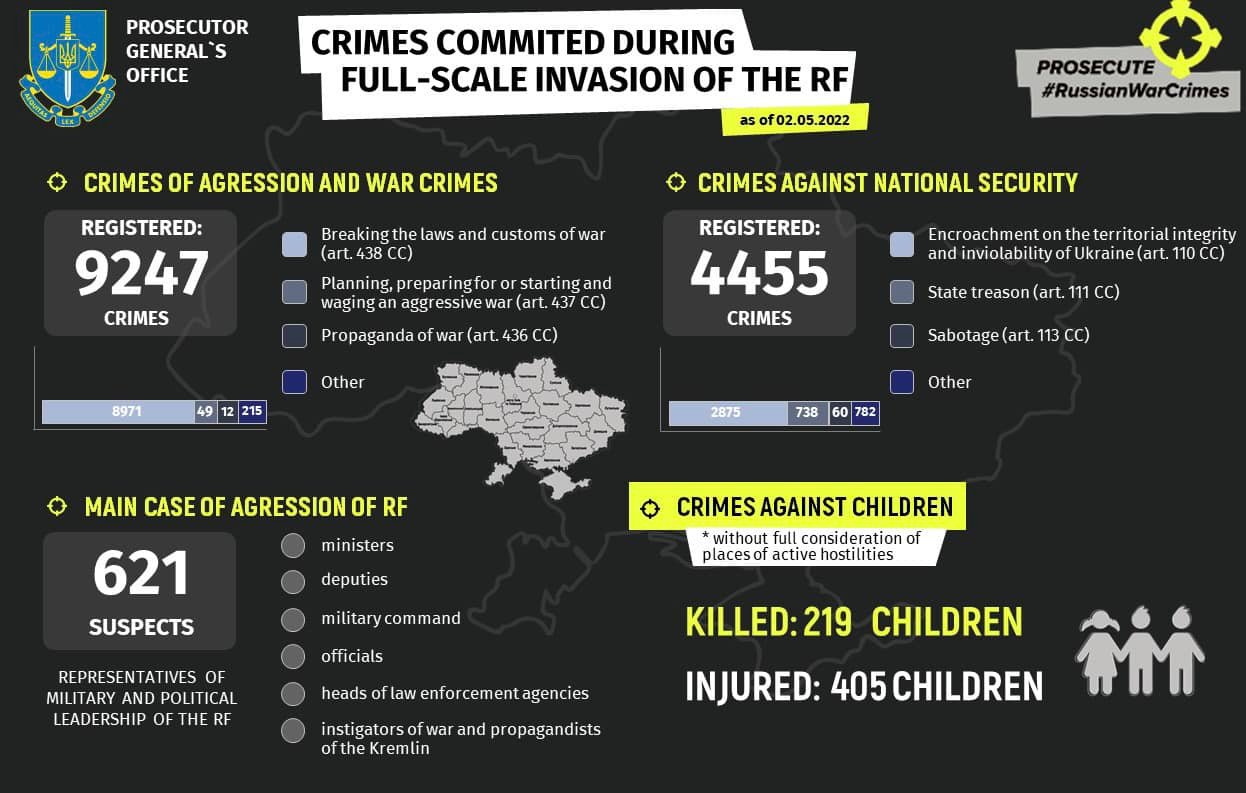
219 children were killed, and 405 children injured, the Office of the Prosecutor General of Ukraine reports as of May 2. 1,570 educational establishments are damaged as a result of shelling and bombings, 111 of them are destroyed fully. 9,247 crimes of aggression and war crimes and 4,455 crimes against national security were registered.
Support
Poland will not support a peace agreement that would include the surrender of Ukrainian territory to Russia, Ukrainska Pravda reports. Warsaw became the first capital among potential guarantor states to publicly declare that it would not take part in such a peace agreement, which would provide for the surrender of part of Ukraine's territory.
“This was stated in an interview with Gazeta.pl on Sunday by Jakub Kumoch, a foreign policy adviser to President Duda and one of the heads of the Polish presidential office. He confirmed that Poland is ready to play the role of "guarantor" in the framework of the ceasefire agreement with Russia if these negotiations succeed.
The diplomat stressed that the draft settlement agreement, which is not disclosed, is a document of Ukrainian authorship. He also set the condition for Poland's participation in this process: "If a peace agreement is reached, we are only interested in one that guarantees the territorial integrity of Ukraine and its independence. And only one document that Ukrainians agree to." He also revealed the details of the talks, noting that the surrender of Donbas and Crimea is not being considered.”
Germany will supply Western tanks to Ukraine only together with other countries, the European Truth reports. Kyiv is asking Berlin to supply Leopard tanks.
"Scholz has made it clear that as long as America and other allies do not send Western battle tanks to Ukraine, Germany will not, Bild am Sonntag commented on its conversation with the chancellor, adding that Scholz is firmly convinced of the correctness of the all or none principle concerning the sale of weapons to Ukraine.”
New developments
1. Russian Foreign Minister Sergei Lavrov said that Russia demanded that Ukraine not give up but stop the resistance. This was reported by Censor.NET with reference to LIGA. "We don't demand that Zelenskyy surrender. We demand that he order the release of all civilians and stop the resistance," Lavrov said.
2. Speaker Nancy Pelosi and Members of a Congressional delegation visited President Zelenskyy. In her statement after the visit, she said that
President Zelenskyy conveyed the clear need for continued security, economic and humanitarian assistance from the United States to address the devastating human toll taken on the Ukrainian people by Putin's diabolic invasion – and our delegation proudly
delivered the message that additional American support is on the way, as we work to transform President Biden’s strong funding request into a legislative package.
Our delegation conveyed our respect and gratitude to President Zelenskyy for his leadership and our admiration of the Ukrainian people for their courage in the fight against Russia’s oppression.”
3. Finland and Sweden intensify talks on joint NATO application, Defense News reports.
“The sudden elevation in the intensity of top-level talks between Finland and Sweden has raised the bar on the expectation that the two unaligned Nordic states will jointly announce their decisions to join NATO by May 16. The prospect for a “joint leap” by Sweden and Finland in to NATO will be discussed when the prime ministers of both countries, Magdalena Andersson and Sanna Marin, meet at Schloss Meseberg castle, near Berlin, to discuss security issues with German Chancellor Olaf Scholz on May 3”.
4. Russia won’t try to complete Ukraine operation by Victory Day, Lavrov says, TASS reports. Moscow won’t set artificial timeframes for its military operation in Ukraine in order to complete it by Victory Day, celebrated on May 9, Russian Foreign Minister Sergey Lavrov said in an interview with Italy’s Mediaset broadcaster.
5. Our President's only goal is to bring Putin and Zelenskyy together, Cavusoglu says, APA reports. "The only goal of our president is to stop the war and bring the two leaders together. We sincerely continue our efforts, "he said.
6. Congressman Adam Kinzinger (R-IL) announced his introduction of a joint resolution that would authorize the use of the US Armed Forces to defend the territorial integrity of Ukraine in the event that Vladimir Putin escalates his unjust war against our democratic allies. This Authorization for Use of Military Force to Defend America’s Allies Resolution of 2022 would authorize the President of the United States to utilize our forces to respond to a scenario in which the Russian Federation uses chemical, biological, or nuclear weapons against Ukraine. “I’m introducing this AUMF as a clear redline so the Administration can take appropriate action should Russia use chemical, biological, and/or nuclear weapons”, he stated.
7. Pope says Mariupol 'barbarously bombarded', implicitly criticizing Russia, the Reuters reports.
“Pope Francis on Sunday described the war in Ukraine as a "macabre regression of humanity" that makes him "suffer and cry", calling for humanitarian corridors to evacuate people trapped in the Mariupol steelworks. Speaking to thousands of people in St. Peter's Square for his noon blessing, Francis again implicitly criticised Russia.
Assessment
On the War
The Institute for the Study of War has made the following assessment as of Sunday 1 May:
Western and Ukrainian sources claimed that Russian President Vladimir Putin may announce a “general mobilization” of the Russian military on May 9th. British Defense Minister Ben Wallace claimed that Putin may make this announcement, although Wallace admitted this was a personal opinion and not based on intelligence. Advisor to the Ukrainian President Mikhail Podoliak amplified Wallace’s claims and stated that a general mobilization on May 9 would be consistent with the economic imperatives faced by Russia as a result of the invasion of Ukraine. ISW has no independent verification of these claims, which would not in any event generate large numbers of usable soldiers for many months. The Kremlin likely seeks to leverage its partners in the Collective Security Treaty Organization (CSTO) to evade Western sanctions. The Ukrainian Main Military Intelligence Directorate (GUR) reported that Russia is courting CSTO members to procure input goods and materials for dual-use technologies that Russia cannot directly purchase due to Western sanctions. The GUR stated that this effort will increase CSTO members’ economic dependence on Russia and enable Russian sanction evasion by using third-party countries to re-export Russian products to international markets. The GUR stated that the Russian Ulyanovsk Mechanical Plant is attempting to obtain German components needed for the production of Buk surface-to-air missile systems and Tunguska missiles via Kazakhstan. Western sanctions may need to target Russia’s partners in the CSTO and Eurasian Economic Union (EAEU) customs union to prevent Russian sanctions evasion. Key Takeaways Russia is preparing provocations in the "Transnistrian region" for the May holidays, the Defense Intelligence of Ukraine (DIU) claims. Unrecognized Transnistria continues to prepare for war with Ukraine. A large circulation of the Transnistrian newspaper, pre-dated to 2 May 2022, has been printed on the territory of the Transnistrian region. The text requests "to involve the armed forces of the Transnistrian region in the actions of the Russian army." To this end, "mobilization points" are being set up in Russia for the recruitment of volunteers to fight in the Transnistrian army. In this way, the Kremlin is trying to legalize thousands of its military who will carry out provocations from the territory of the Transnistrian region. The newspaper also contains a series of propaganda materials about "bloody terrorist attacks on Transnistrians on the May holidays, dozens killed, including children, the elderly and women." As the newspaper was published on the eve of the holidays, there is a danger that the Kremlin authorities plan to commit a series of acts of intimidation among the local population, for which Ukraine and the Collective West have traditionally been responsible. The newspaper's texts are full of Kremlin stamps: "Transnistrians no longer have the opportunity to avoid a big war. Kyiv and its NATO curators have already passed their verdict, they have already coordinated all their actions with Chisinau and Bucharest. " The authors of the newspaper associate all hopes with "opposition to fraternal Russia". Foreign citizens are urged to join the armed forces of Transnistria. Mobilization offices have allegedly been established in the Russian Federation, the People's Republic of China, the Democratic People's Republic of Belarus, Abkhazia, and the Autonomous Republic of Kazakhstan. In addition, citizens of other countries can join our army. By such actions, the Russian leadership can prepare a new springboard for aggression against Ukraine and the basis for the "official" occupation of part of the territory of independent Moldova. Russia ‘is already paving the way for a takeover of Moldova’, The Times reports. “Russia will attempt to open up a new front against Ukraine from Moldova, according to Ukrainian military sources. One said there were a number of indicators pointing to an attack in the near future on the former Soviet state, which has only 3,250 soldiers in its army. A successful takeover would lead to Russian troops moving into the Black Sea port of Odesa, in Ukraine, from the west. We believe the Kremlin has already taken the decision to attack Moldova. The fate of Moldova is very crucial. If the Russians start to take control, we will, militarily, be an easier target and the threat to Ukraine will be existential, said the source.” Consequences and what to do? Ukraine a 'test' for West and international order – US senator, the Ukrinform reports. “The chair of the US Senate Foreign Relations Committee, Robert Menendez, has said that the war in Ukraine is a test for the West, as well as the strength of the established international order in the world. He stated this in an interview with NBC News on Sunday. Ukraine is a test for the west, it's a test for international order. Can one country — this case Russia under President Putin — erase the borders of Europe or change a country by force?" Menendez said. He stressed that the United States is not fighting a proxy war with Russia, as claimed by the Kremlin.” Ukraine Is Now America’s War, Too, Robin Wright argues in The New Yorker. The US is leading a new coalition of “nations of good will” as the goal expands from supporting Ukraine to weakening Russia and outlasting Putin. “America has crossed a threshold in Ukraine, both in its short-term involvement and its long-term intent. The US was initially cautious during the fall and winter ….Two days after long convoys of Russian tanks rolled across the border, on February 24th, the US Secretary of State, Antony Blinken, still claimed that America’s goal—backed by hundreds of millions of dollars in military aid—was simply to stand behind the Ukrainian people. The White House sanctioned Russia—initially targeting a few banks, oligarchs, political élites, government-owned enterprises, and Putin’s own family—to pressure the Russian leader to put his troops back in their box, without resorting to military intervention. “Direct confrontation between nato and Russia is World War Three, something we must strive to prevent,” President Joe Biden said, in early March. Yet in just over nine weeks, the conflict has rapidly evolved into a full proxy war with Russia, with global ramifications. US officials now frame America’s role in more ambitious terms that border on aggressive. The goal—backed by tens of billions of dollars in aid—is to “weaken” Russia and ensure a sovereign Ukraine outlasts Putin. … Having basically run out of appropriated funds, Biden has asked Congress for thirty-three billion dollars—for new military, economic, and humanitarian support—in the latest of several packages for Ukraine. “The cost of this fight is not cheap,” the President acknowledged. (As Politico noted, the new aid is about half the size of the entire Russian defense budget—and also more than half of the US State Department’s annual budget. Over the next five months, US aid to Ukraine will average more than two hundred million dollars a day.) The investment, Biden said, was a small price “to lessen the risk of future conflicts” with Russia. For Putin, the war in Ukraine always seemed to be, at least in part, a proxy fight with nato and its US leadership. Ahead of his invasion, he publicly expressed deep paranoia about the military alliance and its further expansion into countries once aligned with the Soviet Union. He also brokered a five-thousand-word agreement with the Chinese President, Xi Jinping, to form a de-facto alliance of authoritarian regimes. They jointly opposed nato enlargement. Biden tried to resist that framing. At the start of the invasion, the US invoked the principles of sovereignty, a democratically elected government, and territorial integrity. During the past week, however, Ukraine’s existential crisis has increasingly appeared to be America’s war, too. On April 24th, Blinken and Defense Secretary Lloyd Austin took a train with blacked-out windows into Kyiv to meet President Volodymyr Zelenskyy and symbolically reinforce American support. The stealthy trip reflected the increasingly ambitious US goal. “We want to see Russia weakened to the degree it can’t do the kinds of things that it has done in invading Ukraine,” Austin told reporters, near the border in Poland. Blinken said, “We don’t know how the rest of this war will unfold, but we do know that a sovereign, independent Ukraine will be around a lot longer than Vladimir Putin is on the scene.” On Tuesday, Austin assembled defense leaders from more than forty countries—well beyond the nato framework—at Ramstein, a US base in southwest Germany, to coordinate support for Ukraine. Austin … announced the formation of a new coalition of “nations of good will” that will meet monthly to “intensify” an international campaign to win “today’s fight and the struggles to come.” In appealing for more aid, Biden said, “We have to do our part as well, leading the alliance.” The shift may have been inevitable, given the barbarism of the war, which has claimed thousands of civilian lives, and Russia’s challenge to the conventions and obligations of modern statecraft. “If this is left to stand, if there is no answer to this aggression, if Russia gets away with this cost-free, then so goes the so-called international order,” General Mark Milley, the chairman of the Joint Chiefs of Staff, said on CNN. “And if that happens, then we’re heading into an era of seriously increased instability.” … The US has become more deeply engaged for at least four reasons. Diplomacy between Ukraine and Russia has stalled amid revelations of atrocities committed by Russian troops, notably the execution of civilians in Bucha. Moscow’s early participation in peace talks never seemed credible anyway; Putin is too greedy and historically ambitious. Russia has staked claims to southern Crimea, the eastern Donbas region, and the lands between them along the strategic Black Sea. Putin is not yet ready—or, perhaps, not yet under enough pressure—to negotiate seriously. The US has also been emboldened by the stunning underperformance of the Russian military, the largest in Europe. US intelligence had originally feared that Kyiv could fall within seventy-two hours. But Ukraine held the capital, and Russian forces retreated. Washington is no longer hesitant to poke the bear. Yet time still “is not on Ukraine’s side,” Milley reportedly told the coalition of defense leaders at Ramstein. … The growing US involvement also reflects broader fears—long held among countries on or near Russia’s borders —that Putin’s aggression will not stop with Ukraine. On April 22nd, a senior Russian military commander announced that Moscow sought “full control” over eastern and southern Ukraine in part to open the way to neighboring Moldova, a tiny, landlocked country that is supportive of the European Union but dependent on Russian energy. In congressional testimony on Thursday, Blinken cited the urgent need “to seize the strategic opportunities” and address “the risks that are presented by Russia’s overreach as countries reconsider their policies, their priorities, their relationships.” Moscow’s flagrant rhetoric about nuclear weapons has also increasingly alarmed US officials. … The Biden Administration has public support for its expanding role—for now. Despite war-weariness after two decades in Afghanistan and Iraq, roughly two-thirds of Americans believe that the US has a “moral responsibility” to do more to stop the killing of civilians in Ukraine, according to a Quinnipiac poll published in mid-April. In a country polarized on most other issues, a majority from both parties agreed. Three-quarters of those polled also fear that the worst is yet to come. And more than eighty percent believe that Vladimir Putin is a war criminal. Yet the public’s moral outrage “stops at the water’s edge when it comes to committing the US military to the fight,” Tim Malloy, a Quinnipiac University analyst, noted. Only nineteen percent of Americans believe the US should do more even if it risks getting into a direct war with Russia. That conviction may soon be tested. The US role has evolved—from a reactive response to Russia’s unjustified war to a proactive assertion of American leadership and leverage. Perhaps in desperation, Putin’s rhetoric has become bolder. On Wednesday, he warned that he could launch a “lightning-fast” response to any nation that intervened to thwart or threaten Russia. “We have all the instruments for this, such that no one can boast of,” he said, in an apparent reference to Moscow’s nuclear and missile arsenal. “We’re going to use them if we have to.” The war could now play out in many disparate ways. Each carries its own dangers—for the US as well as Ukraine.” “Ukraine a 'test' for West and international order”. “Over 4M tonnes of grain blocked in Ukrainian ports due to war”. “Putin’s war is exacerbating hunger all around the world. His deliberate targeting of food supplies has resulted in great pain inside Ukraine and around the world. Food prices have risen, energy prices have risen. And that in turn means that hunger is on the rise”. “Ukraine Is Now America’s War, Too”. “Congressman announced his introduction of a joint resolution that would authorize the use of US Armed Forces to defend the territorial integrity of Ukraine in the event that Vladimir Putin escalates his unjust war against our democratic allies.” “Poland will not support a peace agreement that would include the surrender of Ukrainian territory to Russia.” These are just some of the international news headlines rendering further comments by me redundant. I have argued that “Ukraine is only an object and not the strategic aim of the Hybrid War. It is a conflict between Russia and the West over the world order, and the conflicting ideas of the authoritarian “Russian World” and the Western liberal democracies. A Russian victory in Ukraine is, however, a prerequisite for its global ambitions.” Since 24 February, I have used these reports to both report on the military part of the conflict as well as highlight the many global ripple effects it causes. On top of the human suffering, a refugee crisis, and Russian atrocities, I have injected some of the many global consequences of the war, like climate, environment, food and energy security, finance, industrial production, inflation, cost of living, maritime transport and global supply chain and not at least political fallout and our common security. These are only some out of many examples of how a war many perceive to be distant has direct consequences for us all. Remaining at a “safe distance” implies accepting the global ripple effects of the Russian war in Ukraine, as we remain hostage to Putin’s aggressive foreign policy in general, and his unprovoked and unjustifiable war in Ukraine in particular. As the West is slowly inching closer to an active partner in the war, the question “what is NATO’s red line” remains more important than ever.
Assessment by Hans Petter Midttun:



